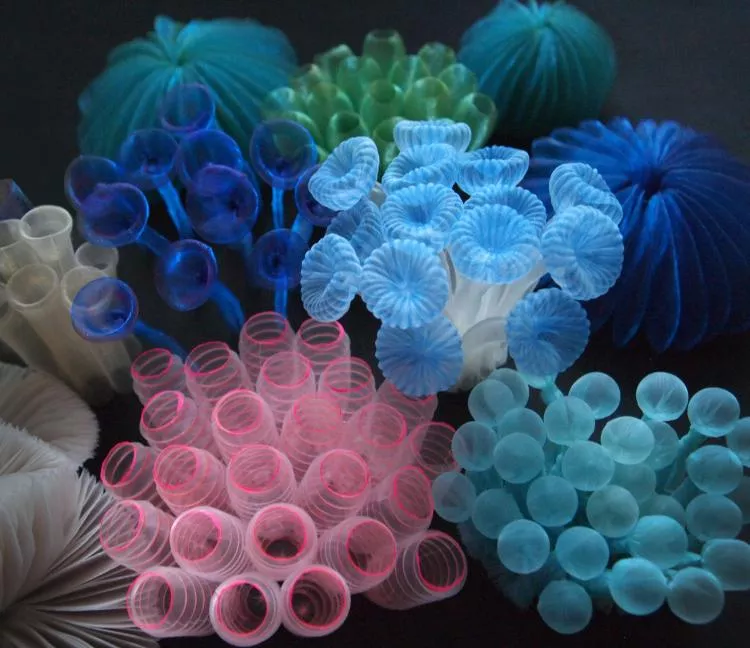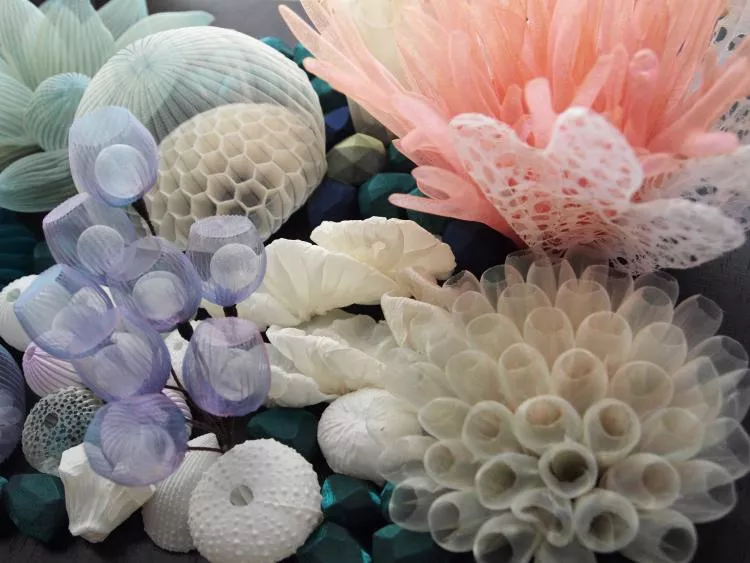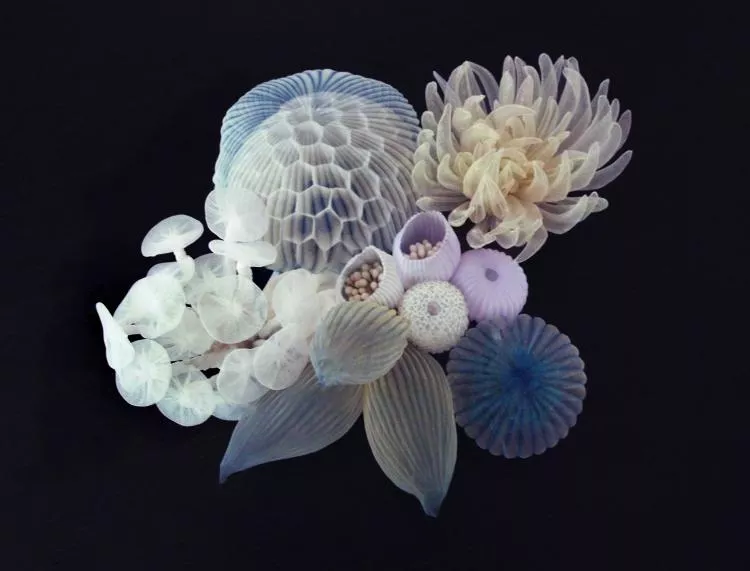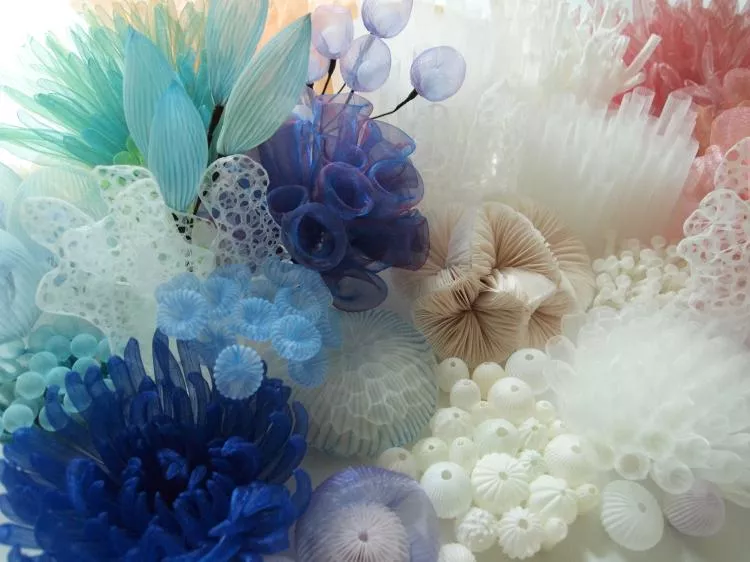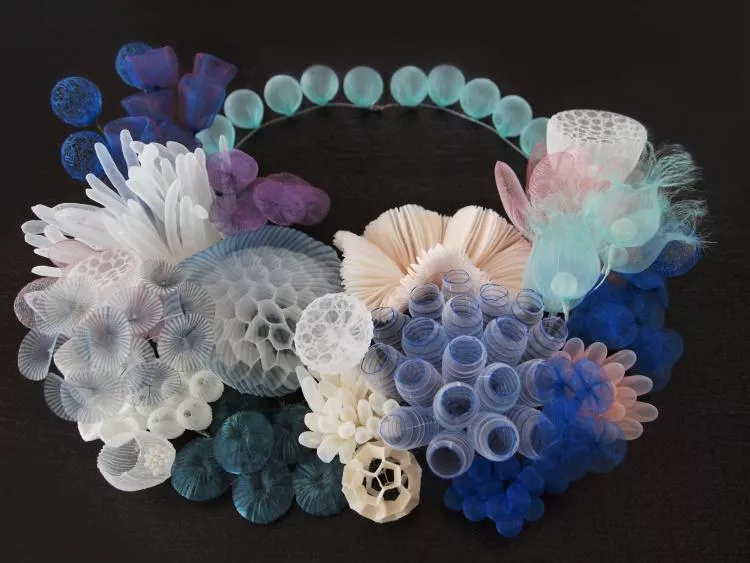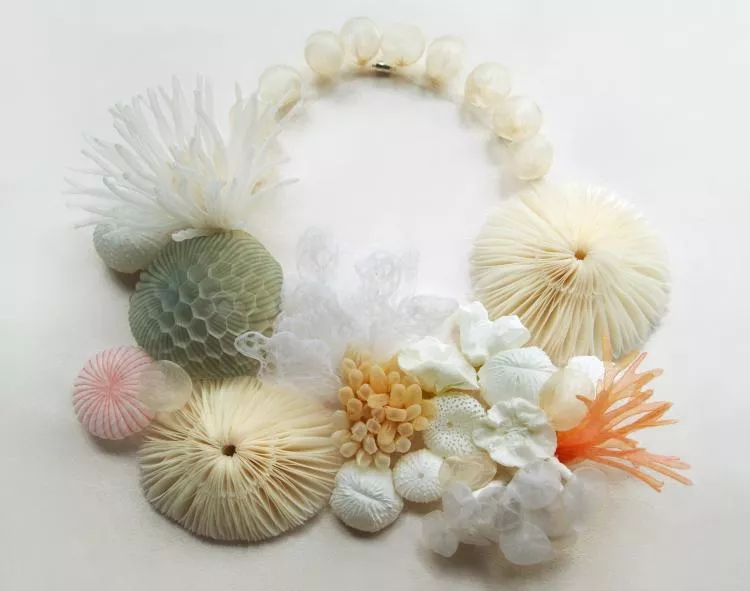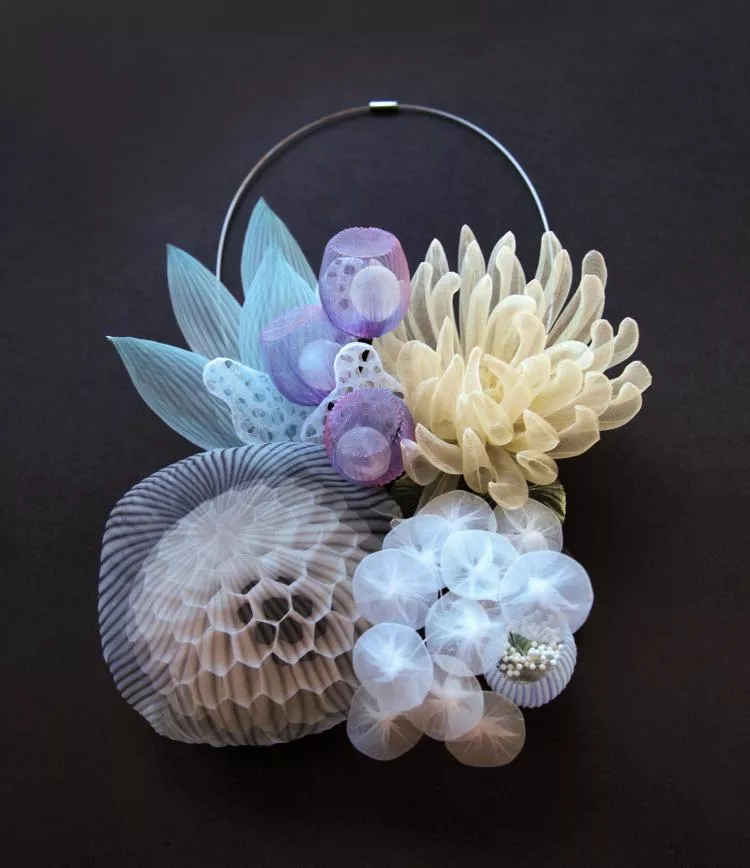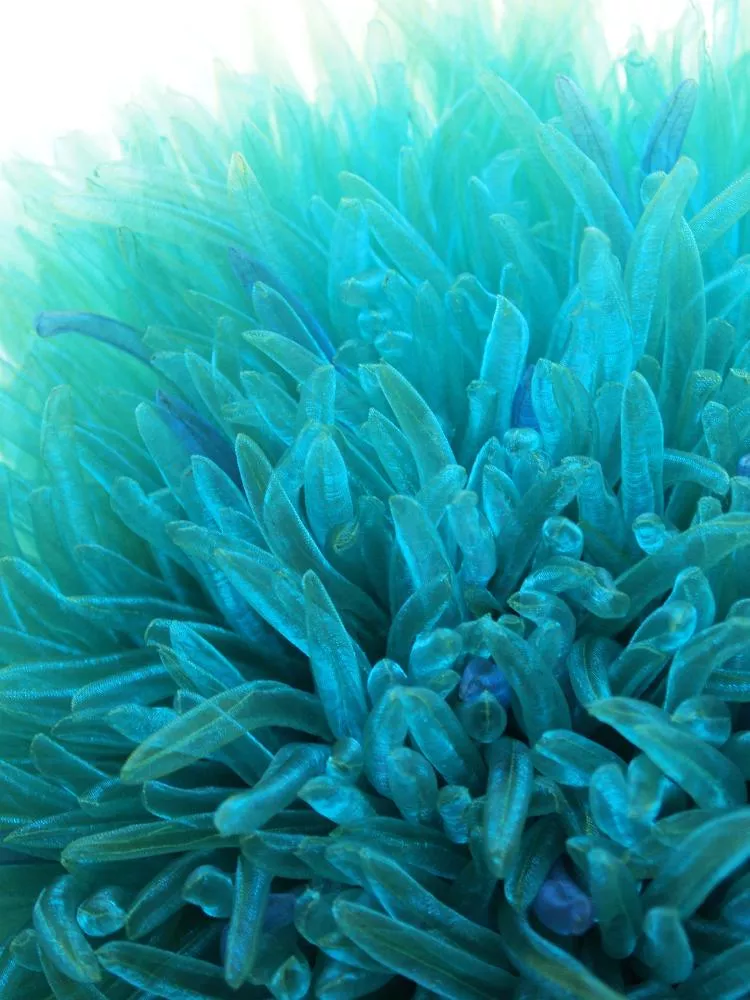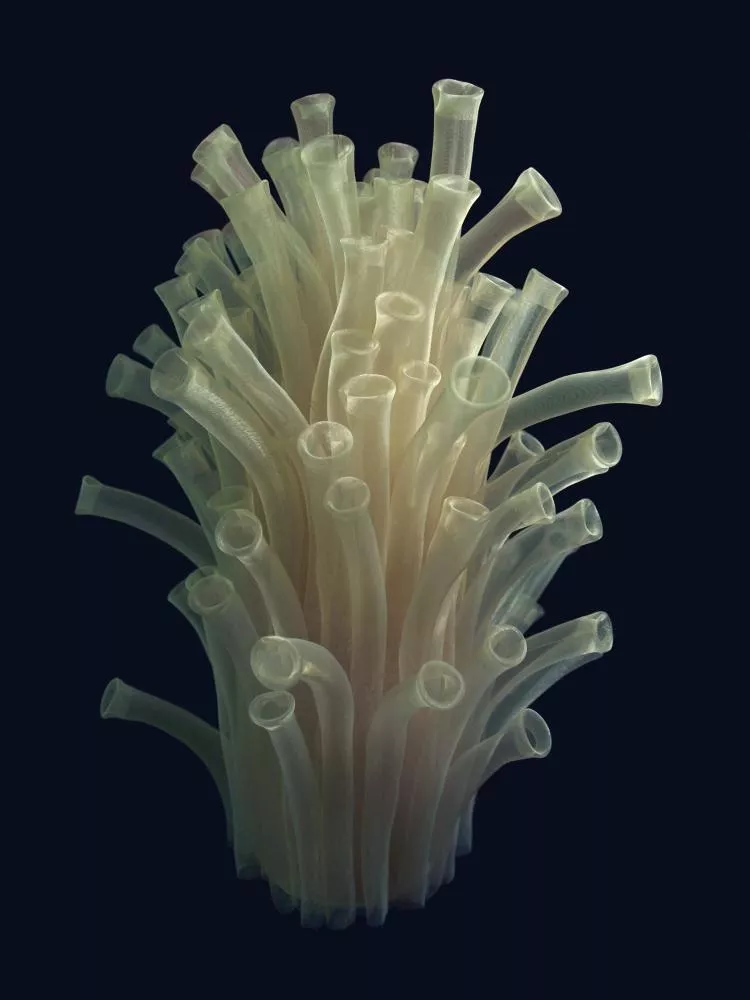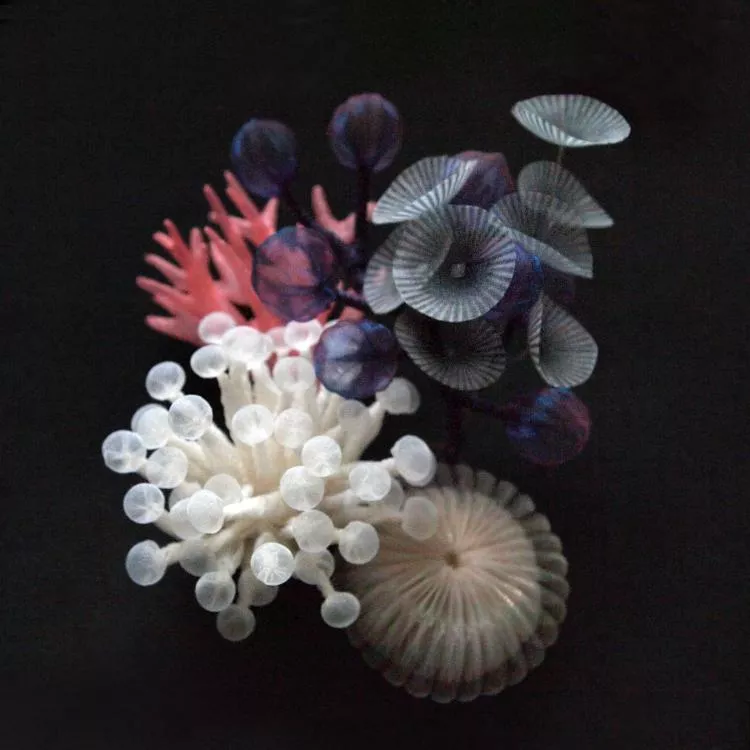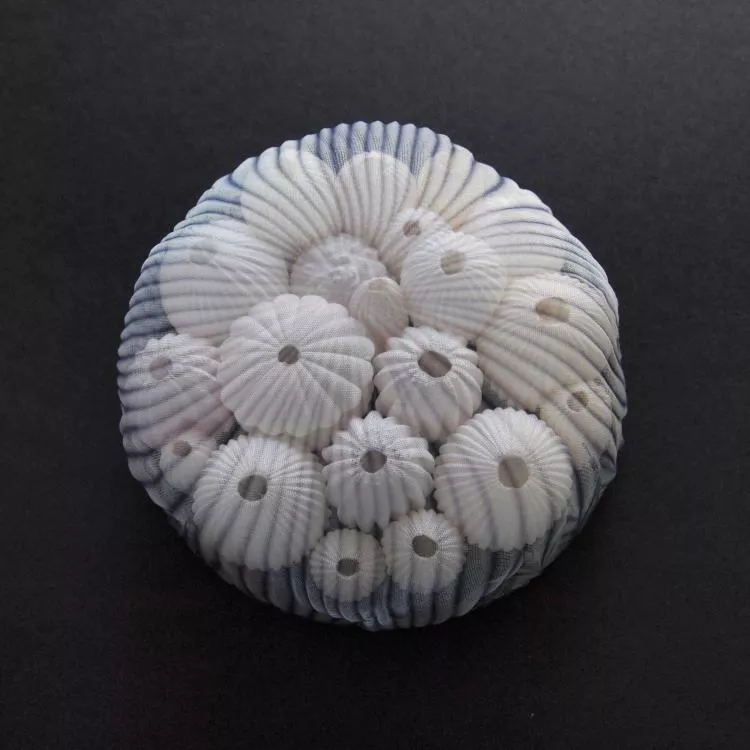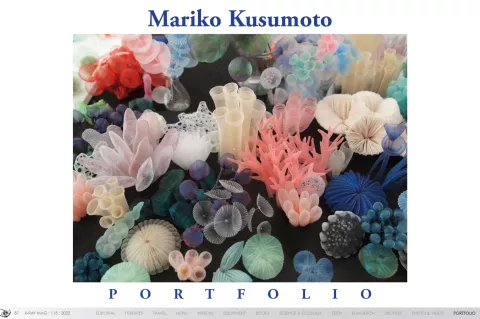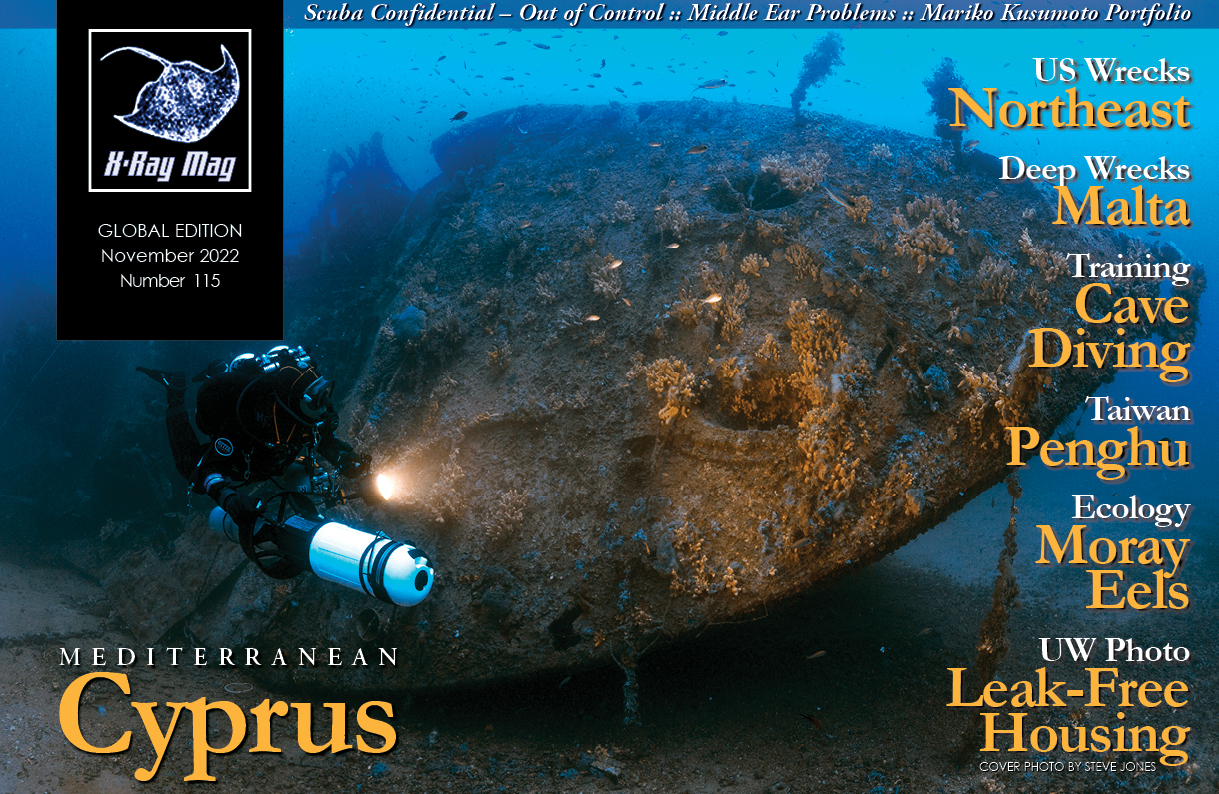Originally from Japan, artist Mariko Kusumoto, now based in the United States, creates delicate, translucent, ethereal, textile sculptures and wearable art featuring colorful reef coral forms in beautiful compositions, which have been shown in Europe, Asia and the Americas. X-Ray Mag interviewed the artist to learn more about her creative process and perspectives.
Contributed by
X-RAY MAG: Tell us about yourself, your background and how you became an artist.
MK: I was born and raised in Japan. Where I grew up in a 400-year-old temple, I was always surrounded by the beauty of nature. As a child, I spent a lot of time outside, especially in the temple’s graveyard, playing with dirt, insects, plants, etc. I was pretty much a nature girl. I was always making things with whatever materials were available, such as my mother’s fabrics, paper and plants. I also drew. I have always had a creative inclination.
When I was 15, I decided to become an artist, so I went to a secondary school that offered a fine art major. There, I gained knowledge about several forms of art, including design, sculpture and painting, and I also studied art history. I had a terrific experience there, and after that I attended an art college. So, I was determined to be an artist from an early age.
After I graduated from art college in Japan, I relocated to the United States and attended graduate school at an arts university. Now, I live and work in Massachusetts.
X-RAY MAG: Why marine life and themes inspired by the sea? How did you come to these themes and how did you develop your style of sculpture?
MK: I like the translucency and the lightness of the type of fabric I use. The sensibility, subtlety, ethereality, fragility and ambiguity are the essential parts of my work, and the fabric can achieve these elements.
I am interested in nature in general, but after I looked closer at marine life, I realized that my artistic style totally fitted an ocean theme.
X-RAY MAG: Who or what has inspired you and your artwork and why?
MK: Fabric itself is incredibly inspiring to me. In my daily life, encountering various kinds of materials is really important to me. I occasionally come across fabrics that mesmerize me, draw me in, and spark my creativity.
Being commonplace, fabric is a familiar material we see every day. Even while the word “fabric” seems simple enough, there are a wide variety of fabrics, each having distinctive qualities that can elicit a range of experiences or emotions. There are materials that evoke the mysterious or the ethereal, those that inspire tranquillity, those that give one a feeling of cool dampness, those that have a soothing fluffiness, or hint at fragility, subtlety, etc.
Since metal, the material I previously worked with solely for many years, is fundamentally the opposite of fabric, I create fabric pieces that reflect my intense interest in the material itself. I try to highlight the fabric’s natural qualities and attractiveness. I give it a new identity by reshaping it into three-dimensional sculptures, using a heat-setting procedure. For instance, I enjoy the translucent nature of fabric, because it enables me to work with layers, adding or removing components to create fun, enigmatic and ethereal atmospheres.
In addition to the fabric itself, the creative process inspires and motivates me. I spend half my creative time experimenting with things. At times, there is a breath-taking moment during this process. I take note of these intuitive discoveries, using these happy accidents as the foundation for fresh ideas and build from there. I have not even scratched the surface of what I might do with fabric. So, I continue to explore and discover the limitless potential of the materials I work with.
X-RAY MAG: What is your artistic method or creative process?
MK: I use different kinds of techniques, but mainly, I use a heat-setting process. This technique makes the shapes permanent in synthetic fiber when it is heated to a certain temperature. I use different kinds of molds to create those shapes.
First, I wrap the mold with fabric, and then I put it in the oven for 20 minutes. Then, I remove the mold after it has cooled down, and now the shape of the fabric is permanent. It is a very simple technique.
X-RAY MAG: What is your relationship to the underwater world and coral reefs? In your relationship with reefs and the sea, where have you had your favorite experiences?
MK: I have never done scuba diving nor have I had any experiences with underwater life, unfortunately. Hopefully, I will have the chance to explore and see the underwater world in real life in the future.
The beginning of my interest in marine life was when I by chance watched a documentary film about the deep ocean. I was very shocked that I did not know anything about what was down there. I could not believe what I was watching—bizarre and very beautiful sea creatures that I had never seen before. I thought they were “artwork” in and of themselves. Not only that, but I was also surprised to learn that there were still so many things that have not been discovered yet. The ocean is full of mysteries, and I was immediately drawn to that world.
X-RAY MAG: What are your thoughts on coral reef conservation and how does your artwork relate to these issues?
MK: Some of my pieces are in the permanent collection of art museums. Museums do the best job of preserving artwork in their well-equipped environments. From that point of view, long-lasting materials like plastic might be a good material for preservation purposes, and I often use synthetic fibers such as polyester and nylon fabric, which are essentially plastic. However, when plastic is treated as a disposable material and its waste spreads everywhere, it becomes harmful and a threat to the environment and living things.
While I create a lot of sculptures, I also create wearable pieces that have small components. So, in order to minimize waste, I save all the scraps of fabric left over from larger artworks and use them for creating tiny parts.
To me, synthetic fiber is not a disposable material, in the way I use it. I do my best to bring plastic to a higher level.
Meanwhile, I try to do what I can for the environment in my daily life. I do not buy take-out food very often because it usually comes in plastic containers. I also use chemical-free products for the yard and laundry, and I compost leftover food, reuse bags, etc.
However, I still have guilt, because I use plastic in my work—it does not matter how minimal it is. And I cannot seem to avoid using plastic, such as the packing tape used to pack and ship my pieces, the face masks worn at work, the polyester-filled cushions and comforters I sleep with, and most of the garbage inside my trash bags is unrecyclable plastic wrapping and packaging from groceries, etc. It seems like our lives cannot exist without some plastic, and it is hard to imagine how people could survive without it in the old days.
I do strive to buy much of my materials from second-hand thrift stores, and not just fabric stores. I love going to thrift shops and flea markets where I look for second-hand fabrics. Usually, they are fabric remnants, curtains, clothes, scarves, etc, and I use them to create my pieces.
X-RAY MAG: Would you consider this “upcycling,” and how so?
MK: I add value to these second-hand fabrics, so I would say “upcycling” is accurate. However, sometimes I have a hard time finding what I am looking for, so I end up buying some new fabric.
However, I hope the use of biodegradable materials takes over completely in the future, although it might be a long time before it becomes widespread.
My creations may not directly relate to ocean and coral reef conservation, but at least what I can do through my work is to show my discoveries and interpretation of the beauty of marine life and promote awareness of this amazing world.
X-RAY MAG: What are the challenges or benefits of being an artist in the world today? Any thoughts or advice for aspiring artists in ocean arts?
MK: Before the internet, artists were limited in how much of the world they could expose their work to because they had to rely on galleries, magazines, etc. But now artists can expose audiences, globally, to their work through social media, which is an amazing tool for promotion. There is no reason not to make use of it. So, I encourage aspiring artists to use this tool and expose as many people to their work as they can. There are lots of possibilities in front of us.
X-RAY MAG: What is the message or experience you want viewers of your artwork to have or understand? How do people respond to your artworks?
The thing I like about my work is that it is not hard to understand. I want to create something that is simply beautiful, which speaks directly to the viewer, regardless of their age, race, gender, etc. I want the pieces to be able to stand up by themselves, without needing explanation.
“Simply beautiful” may sound straightforward and easy to say, but it is not necessarily easy to do, I think. But, needless to say, it is the most powerful and universal thing. I am always surprised by how strongly people react to my work.
Besides sculpture, I also create wearable pieces. The owners of my work often say that people always talk to them whenever they wear my pieces. It may just be an object, but I like the way that it connects people. It is interesting to see how the object positively affects people’s emotions and minds.
X-RAY MAG: Several of your beautiful artworks of coral forms are now included in the permanent collections of museums such as the Victoria and Albert Museum in London, the Renwick Gallery of the Smithsonian American Art Museum in Washington, DC, the Museum of Fine Arts in Boston, and the Decorative Arts Museum in Paris. Please tell us how this came about.
MK: My marine theme pieces seem to be very popular. One museum curator contacted me directly and requested me to make coral forms, and other museums purchased my work through the galleries. Also, I used to have my production pieces at the Museum of Modern Art store in New York. Jean Paul Gaultier discovered my work and it led to a collaboration for his Spring/Summer 2019 Paris Fashion Week show. I contributed to 18 of the 63 looks in the show, and one of the looks became part of the permanent collection of Museum of Fine Arts in Boston.
X-RAY MAG: What are your upcoming projects, art courses or events?
MK: I will have an exhibition at the Morikami Museum and Japanese Gardens in Florida in the fall of 2023, where I will be showing both sculptures and wearable pieces.
For more information, please visit the artist’s website at: marikokusumoto.com or follow on Facebook @MarikoKusumotoArt or Instagram @MarikoKusumoto.

